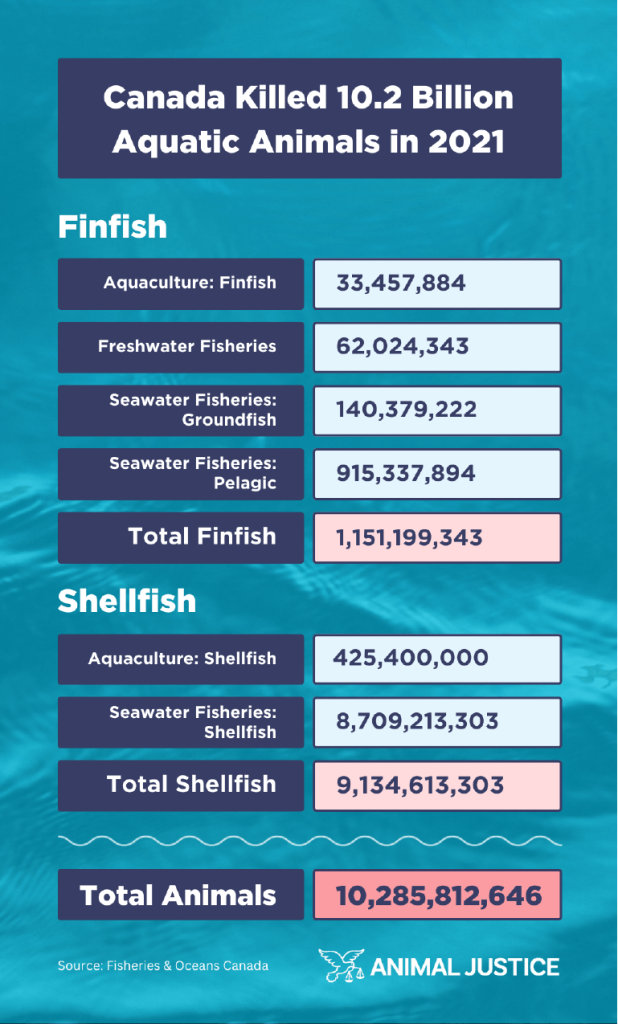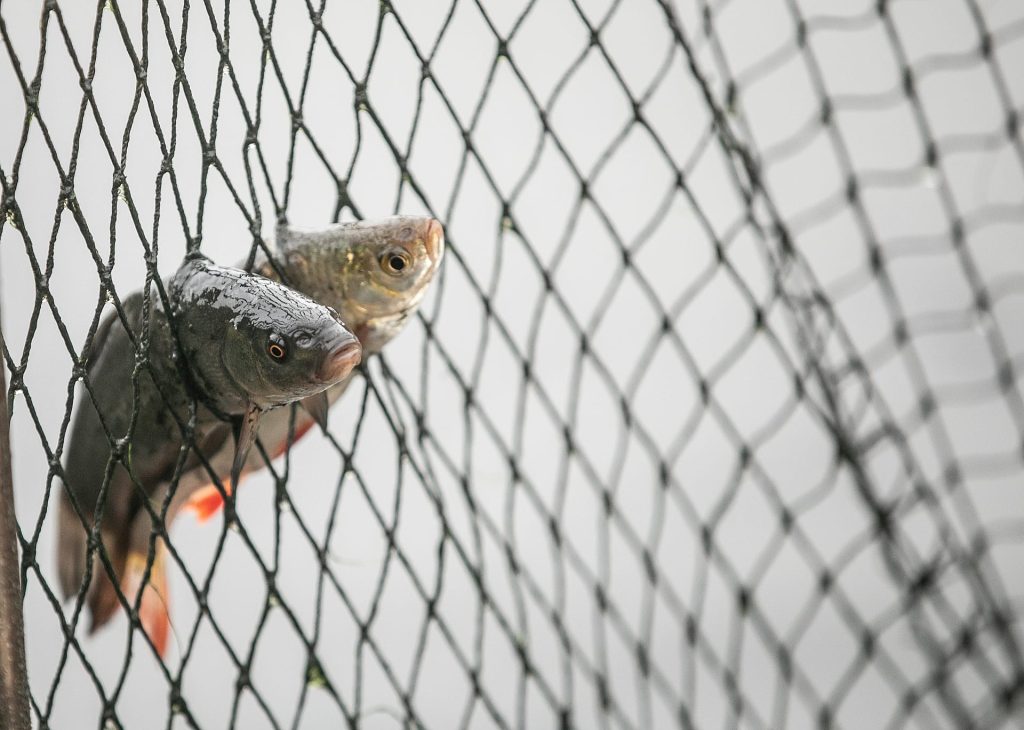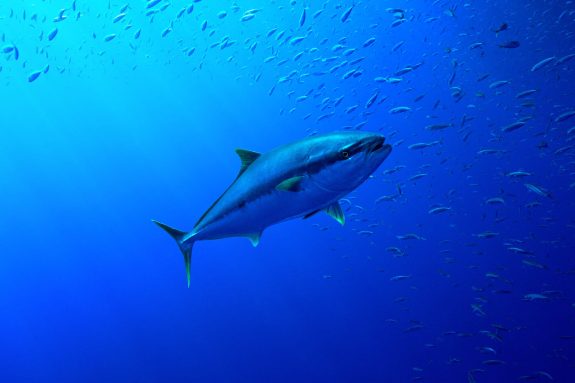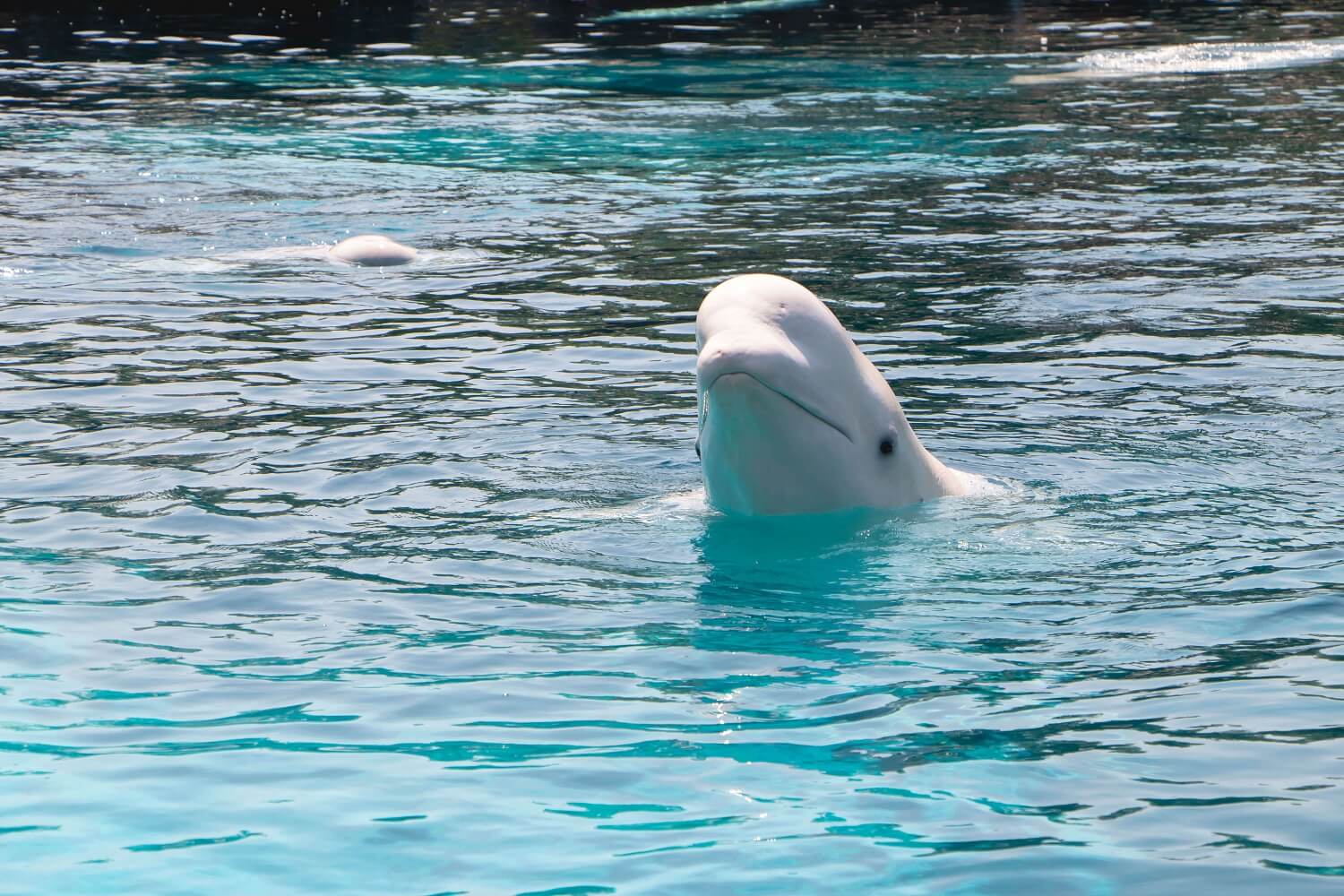For years, Animal Justice has tallied the numbers of land animals who are killed every year for food in Canada. And now, for the first time ever, Animal Justice is releasing an estimate of the number of aquatic animals killed for food in Canada.
Aquatic animals aren’t counted as individuals in government statistics. Instead, the industry only measures the scale of their “harvest” by their collective weight in tonnes. This makes it complex to get a full picture of the heartbreaking death and destruction caused by fishing and farming aquatic animals for food.
How We Got the Numbers
Fortunately, the annual weights reported by the Department of Fisheries and Oceans (DFO) are at least categorized by species. We divided the total landing weight of each species by the average weight of an individual member of that species. This allowed us to come up with a rough estimate of the number of individual aquatic animals killed each year in the aquaculture and fishing industries.* Looking at the data for each species in the DFO landing reports, we arrived at an absolutely staggering number of lives lost to commercial fishing.
By our estimate, over 10.2 billion aquatic animals were killed by Canadian fisheries and fish farms in 2021. That’s over 12 times more than the already shocking number of land animals killed each year.

Majority of Salmon Killed Are Bred in Fish Farms
Around 1.1 billion of these deaths are finfish species like salmon, tuna, perch, cod, and catfish. Most of these finfish are killed in ocean or freshwater fisheries, but some species like salmon are overwhelmingly farmed in crowded, disease-ridden fish farms that have devastated coastal inlets in British Columbia with outbreaks of sea lice, infectious salmon anemia virus (SAV), and piscine orthoreovirus (PRV). In 2021, 936,667 salmon were wild-caught in fisheries, and 30,046,500 were raised in fish farms. Canadians should know that if they’re eating salmon, it almost assuredly comes from fishes confined in these horrifying fish farms.

Shrimps Killed More Than Any Other Animal
Shellfish account for the overwhelming majority of deaths, with more than 25 million individuals killed every single day. This category includes lobsters, who are often kept alive in grocery stores and restaurant refrigerators until they can be boiled alive.
At 7.5 billion lives lost, shrimps alone account for nearly three quarters of all aquatic lives targeted for human consumption. To put that into perspective, there are almost as many shrimps killed for food each year in Canada alone as there are humans alive on earth. Worse yet, shrimp trawling is among the worst fishing methods for both ecosystem destruction and bycatch. A shrimp trawl is a weighted net that gets dragged along the ocean floor by fishing boats, tearing up the habitat and capturing almost every living creature in its path.
It’s important to note that Animal Justice’s numbers do not include bycatch—fish and other ocean wildlife who are not the target of a fishery, and who are generally discarded by fishing industries after they are caught. This could include dolphins ensnared by the tuna fishery, or finned fishes caught by trawlers looking for scallops. By Oceana’s estimate, accounting for bycatch may nearly double the number of lives lost to the commercial fishing industry. While there are measures that can be put in place to limit the amount of bycatch, the fishing industry has made little effort to limit its destruction.
Animal Justice’s estimate also leaves out the incalculable damage done to aquatic animal populations when their habitat is destroyed by trawlers or fish farm pollution, and animals ensnared and killed by “ghost gear“—nets and other fishing gear lost or abandoned at sea.

Photo: Andrew Skowron | We Animals Media
The number of aquatic animals killed for food annually is so enormous that it is difficult for us to understand. But each and every animal killed by the fishing industry is an individual. Each animal is dragged out of their home only to be brutally killed by being beaten, suffocated, frozen to death, or cut open alive. Although Canada has a few bare-bones laws to protect land animals killed for food, there are no laws to prevent aquatic animals from suffering while they are fished, farmed, or slaughtered.
Fishes Feel Pain
The evidence is clear: fishes and other aquatic animals are sentient creatures who can feel pain and are capable of suffering—including non-vertebrate creatures like octopuses, crabs, and lobsters. Aquatic animals are also vastly more intelligent than many people previously assumed. Many fishes can use tools, recognize themselves in a mirror, and recognize other fishes. Aquatic animals deserve respect and legal protections.
At Animal Justice, we believe all animals deserve protection from cruelty and neglect—including fishes and other aquatic animals. Our mission is to overhaul the legal system to better reflect our country’s values of compassion and justice for all—including those in the sea. Please join us, and please consider leaving fishes and other aquatic animals off your plate.
*We use average weights for each species from the DFO Aquatic Species Identification website, and for those species who aren’t listed, we found credible sources elsewhere. In cases where a range was given, we used the mean. In cases where only maximum weights were listed, we used those numbers. As a result, the estimate as a whole leans toward a conservative total.



